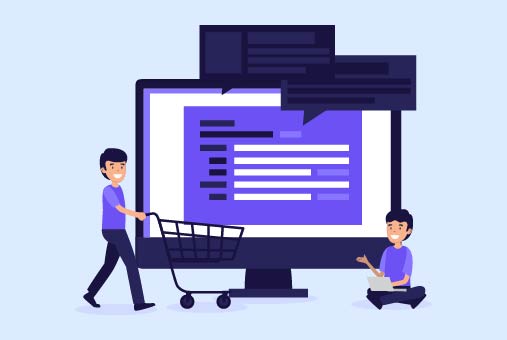
Best Software Engineering Practices for Secure E-commerce Data Migration
Online businesses survive on the data they get from e-commerce. With the growth in these companies, the migrations of servers, or being able to optimize databases, protecting sensitive customer data is crucial. Reducing risk by following security best practices during data migration ensures that the transition goes without an incident. It discusses techniques and guidelines for moving e-commerce data securely with industry-standard software engineering principles.
Plan Architecture and Resources
Planning and resource allocation are key to a successful data migration. Provide detailed data flow diagrams describing the current infrastructure and wanted future infrastructure. Review all hardware and software components of the system in order and capacity planning the system for any additional workloads such as additional storage and processing power.
Based on data volume, calculate the needs for the network bandwidth and define the service level agreements for the acceptable downtime. Design with an eye towards the provision of adequate resources upfront to handle peak migration loads in order to keep performance high.
For professional engineering services and support throughout your migration journey, visit https://www.luxoft.com/services/engineering-services.
To avoid overlooking potential issues, it’s better to build contingencies for anything that could go wrong during the migration process. A study by Software Magazine found that 43% of U.S. companies experienced resource-draining system downtime during their most recent data migrations. If in-house systems don’t scale enough, an additional budget should be allocated to supplement with cloud infrastructure or subscribe to a managed service provider.
Follow Security by Design Principles
Security must be front and center when re-architecting e-commerce platforms and data pipelines. Modern applications use a Software Development Lifecycle incorporating DevSecOps to embed security at every step, including:
- Threat modeling to find weaknesses
- Static application security testing to catch bugs
- Dynamic scanning to probe running apps
- Infrastructure security to protect networks/APIs
Microservices and APIs’ first type of patterns introduce a new type of complexity to cloud architectures. Enforce the least privilege and encryption everywhere from a zero-trust perspective across environments. Controls should also be integrated regarding access management, change control, vulnerability management, and log aggregation.
It helps maintain consistency as infrastructure evolves when standardizing security policies, SDLC checkpoints, and compliance reporting. Post-migration, all controls are verified through regular audits.
Manage Encryption Keys
Encrypting e-commerce data protects sensitive information like customer credentials and payment details from unauthorized access or theft. As applications move across domains, properly managing keys remains imperative to decrypt data when needed.
Use the Hardware Security Modules or Cloud KMS solutions to follow strict key creation policies. Key rotation policies should be enabled to update encryption periodically. Secure hierarchical key access and administrative access control that grants the appropriate personnel access to privileged access.
Automate the seamless propagation of keys to new locations as part of data pipelines. With thoughtful cryptography hygiene, companies avoid effectively locking themselves out from their encrypted data during migrations.
Validate Data Integrity
Guaranteeing complete, accurate data transfer prevents business disruption after switching environments. Establish quality assurance checkpoints that confirm the fidelity and security of information prior to cutovers, including:
- Schema and metadata validation
- Statistical analysis to verify expected data volume and distributions
- Spot checks for data accuracy and consistency
- Validation of key business metrics and KPIs
First, test runs are performed by migrating copies of datasets to lower environments. Then, the results are compared against source systems, tuning extract, transform, and load (ETL) pipelines until parity is achieved. This staging approach surfaces any transformation or data quality issues to fix beforehand.
Cut Risk With Incremental Migration
When migrating data on a large scale, move data in batches and not in a single mass transfer. This stage of migration ensures no downtime or problems that could impact operations all over the globe if issues begin to crop up. Establish thresholds for the success of each batch and ensure that the process is stable before moving on.
Technical teams have breathing room to fix problems as they pop up with an incremental rollout. In addition, they can use these metrics to optimize migration processes over time based on transfer speed, data validation checks, access latency, and error rates if major problems arise that affect SLAs and roll back batches smoothly to previous working states.
To migrate, choose periods of lowest traffic and redirect a percentage of users to new systems until the full production rollout is reached. This keeps revenue flowing while minimizing the load on data pipelines. To limit downtime exposure, schedule shifts in short windows during off-peak hours.
Secure Decommissioning
Following successful data migrations, properly decommission legacy hardware, software, and cloud services without leaving behind loose ends. Wipe disks on premises using approved methods, such as multi-pass random writes or physical destruction, prior to disposal. Automate or use purpose-built tools for decommissioning on cloud infrastructure.
Scrub backups or snapshots holding e-commerce data across all tiers of infrastructure. Remove unauthorized access by former employees or vendors and back up audit logs for retention. Fully deactivate old accounts, applications, keys, and credentials prevents backdoors from leading to data.
Conducting decommissioning in a structured manner ensures no vestiges linger, which could expose consumer details later. Also, documentation must always be updated to reflect changes.
Choose Strategic Migration Partners
While lifting and shifting e-commerce platforms seems straightforward, many organizations underestimate the effort required to do it securely. Working with specialized managed service providers simplifies complex migrations using vetted blueprints and dedicated technical resources.
Proven methodologies for businesses to go through the data migration lifecycle are owned by strategic partners. They work with the business KPIs and develop detailed project plans with contingencies to minimize downtime. Behind the scenes, technical teams take good care of building custom scripts and ETL processes that deliver seamless data syncs, as well as taking care of encryption and key management.
Leading providers provide solutions for on-prem, multi-cloud, hybrid infrastructure, and SaaS platforms. They have worked in domains such as retail, finance, healthcare etc. Data migrations are tailored based on the best practices that they can apply, and they come up with ways to get around compliance hurdles. For businesses migrating to AWS, an agency with AWS migration services can help streamline this process, providing automation, security, and cost efficiency. These services facilitate workload assessment, data transfer, and post-migration optimization, reducing operational risks. After launch, they also partner to set governance for long-term management.
Adopt Agile Processes
Data migrations are a never-ending process that does not stop with implementing the first application portfolio. The agile approach is taken here by continually iterating to manage this ever-changing landscape better than traditional waterfall development.
Dedicated scrum teams focusing on data migration foster expertise in evolving e-commerce architectures. They create backlogs to tackle projects iteratively in sprints, testing infrastructure assumptions and tooling. Continuous process improvement identifies better ways to streamline complex tasks like schema transformations, encryption, and key management.
When migrations involve custom mobile or single-page apps with frequent code pushes, integrating data syncs into CI/CD pipelines adds velocity. Testing data sync tasks for each build provides confidence at scale across microservices environments.
With Agile, cross-functional teams collectively own migrations. By using infrastructure like code, automation, and the DevOps culture, we gain enhanced and more robust and secure data motion abilities that react quicker to the needs of businesses.
Master Data Management Principles
As nearly all data are now intrinsically internet data, the increase in the volume of the e-commerce data and the complexity of e-commerce infrastructure expand exponentially; it is important to manage the sprawl. With Master Data Management (MDM) practices adopted, visibility and control are adopted to improve the quality, security and responsiveness of migrations.
Well-governed MDM programs standardize how organizations define, integrate, and share core business data such as customers, products, financials and more. Data stewards document authoritative sources of truth and apply consistent security rules and access policies enterprise-wide. Relying on golden records and master data helps guarantee fidelity when shifting systems.
Integrating master data into migration templates, scripts and ETL tools ensures uniformity. Validation checks before cutovers identify discrepancies to cleanse. These foundations prevent “bad data” from accumulating across stacks, causing integrity issues.
Utilizing MDM for ongoing data lifecycle management provides a trustworthy baseline for migrations. Teams can rapidly map data relationships between legacy and modern systems while maintaining security. IT and business leaders gain a trustworthy baseline by assessing migration ROI and total cost of ownership. By incorporating Snowflake ETL solutions, teams can efficiently navigate the complexities of data migration and ensure a secure transition.
Adhere to Compliance Mandates
Depending on the information collected and the industry served, e-commerce platforms need to follow an array of legal and regulatory compliance directives on data security, privacy, etc. HIPAA, PCI DSS, GDPR and other mandates, sensitive data is bound, fines and reputation damage to avoid, so prescribed controls must be followed when handling sensitive data.
When migrating companies, during the process of validation, we make sure all systems and processes are compliant and that migrating companies meet compliance requirements. Beforehand, policies, procedures, access controls, encryption and security incident protocols should all be reviewed. Finally, post-migration audits should be conducted with the evidence retained by regulators. All compliance documentation and reporting procedures should be updated to reflect new platforms or architecture.
Failure to maintain compliance during transition periods leaves the door open for enforcement action. Partnering with specialized consultants or auditors to objectively assess readiness clears potential blindspots. They validate that security controls work properly after migrating so customer data stays protected at all times.
Test Extensively Before Go-Live
E-commerce data migrations involve a maze of people, processes and technologies. Before launching a full production rollout, conduct end-to-end testing under load to confirm everything interconnects properly.
The integration testing can start early by establishing baseline performance and expected functionality. Data migration components such as networks, hardware, databases, applications, APIs, security controls and orchestration tools can be dismantled. Real-world workloads and data volumes can be run to validate the capacity planning and SLAs. This will reveal the choke points or bottlenecks that need to be addressed earlier.
This helps mirror the real-world conditions during the expansion to full system testing in staging environments. Based on business criticality, create test cases for the key customer journeys, such as signup flows, placement orders, inventory checks and payment processing. Conduct both positive path testing to confirm normal operation and negative testing to account for failures, delays or exceptions.
Measure against pre-migration baselines for essential benchmarking. Fully clear testing hurdles before scheduling cutovers. This prevents teething issues from derailing business operations and protects precious customer data.
Choose Dedicated Migration Tools
While custom coding data migration scripts scales for simpler projects, specialized tools better meet enterprise needs. Commercial data migration software boasts advanced capabilities streamlining complex transitions securely, including:
- Automation frameworks to orchestrate and monitor data syncs
- Connectors linking disparate databases and data sources
- Data type conversion and schema transformation
- Data validation checks and reconciliation
- Conflict resolution to handle duplicate records
- Encryption, tokenization and data masking
- Detailed logging and auditing
Data migration projects are integrated with governance features that let these projects be managed across siloed teams. Central repository portals draw all the key documentation, including schema maps, data dictionaries, ETL workflows and testing reports and make them transparent.
Pre-built templates with mapped business data components for various customer, order and inventory data models exist within these toolsets. That allows you to migrate more quickly, leaving all the custom coding unnecessary. The purpose-built tools have structure along with best practice blueprints to keep data transitions on track.
Embrace DataOps Culture
Modern data-driven organizations thrive on real-time, accurate information. To securely support more nimble e-commerce operations, adopt a DataOps model promoting greater collaboration between security, IT and business teams across the data lifecycle.
DataOps helps migrate large-scale data at a faster pace but in an organized manner. Development teams and embedded ops members work together to implement migration scripts and ETL processes. They offer operational perspectives that take into account the data usage requirements downstream, security requirements, and performance SLAs.
Central migrations are overseen by cross-department data committees. The insights from members from across business units help in understanding the current data pain points and the outcome that they want from modernization projects. They play an important role in crafting migration roadmaps that enable the most value from data based on data value.
Using Agile DataOps practices brings more resilient data pipeline infrastructure. After migrations are complete, next-generation e-commerce analytics, customer experiences and business insights run on trusted, timely, secure data, which is fed by unifying formerly disjointed teams around which data to feed.




